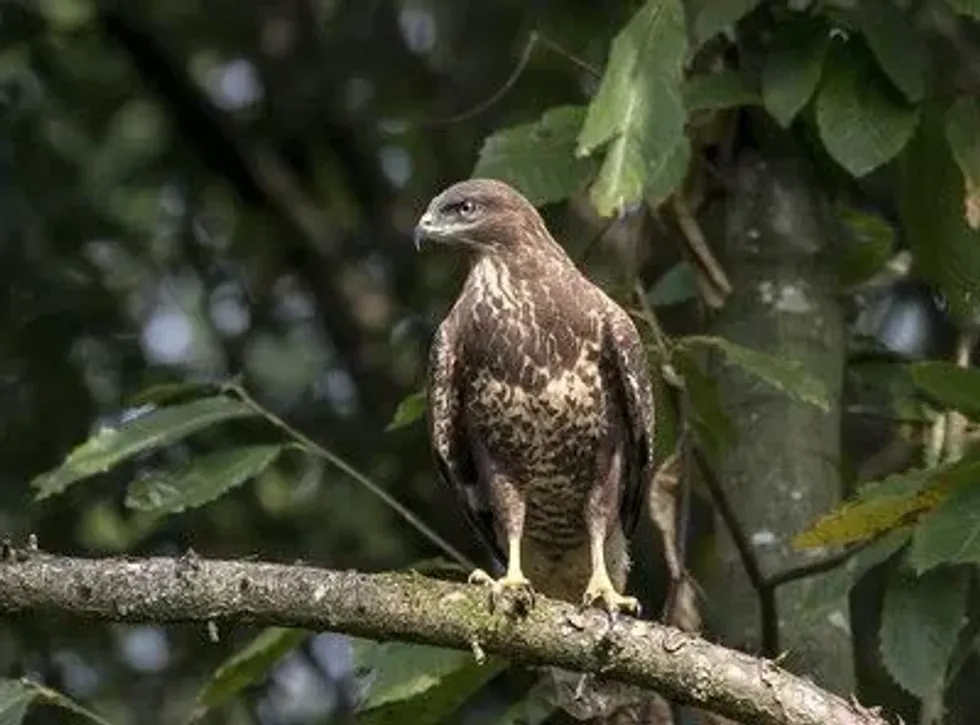If you are fascinated by animals and birds in the wild then you might be eager to know more about the common buzzard. In this article, you will find all that there is to know about this bird subspecies.
Common buzzards are medium-sized birds that belong to the Buteo genus. They are different from the common hawk as they belong to a different family, but they are sometimes referred to as hawks in America.
You can identify common buzzard birds from the color patterns of brown and white feathers all over their body. They are known for being a symbol of destruction in many regions.
The buzzard communicates or calls using a hiss or a squeal to notify its partner of any dangers.
Common buzzards are known simply as buzzards in European and Asian countries, and the rufous morph is the most common type of steppe buzzard found in America. Read on to find more information about this amazing bird!
Common Buzzard Interesting Facts
What type of animal is a common buzzard?
The common buzzard is a type of bird.
What class of animal does a common buzzard belong to?
The Common Buzzard belongs to the class of birds which is also known as Aves.
How many common buzzards are there in the world?
There are 28 species of buzzards and it is estimated that there are no less than 700,000 pairs of common buzzards living today in the world.
Where does a common buzzard live?
Common buzzards are generally known to live in the countryside, farmlands, and woodland. They like living in open spaces or at the edge of forests. Sometimes they can also be seen in mountainous terrain and wetlands.
What is a common buzzard's habitat?
Common buzzards are most commonly found on the European continent. Countries like the United Kingdom, France, and Greece have frequent sightings of this bird population. They are also found in Asian countries like India, Mongolia, and China. The population is known to migrate to African countries during the winter too.
Who do common buzzards live with?
The common buzzard is a bird of prey and prefers to hunt alone. The birds of these species love their solitude and live with just their partner in the nest. They have a very strong bond with their partner and form a team to defend their territories.
How long does a common buzzard live?
The common buzzard has an average life span of eight years. Interestingly the oldest known common buzzard lived for 25 years, but that is an extremely rare scenario. Sadly, in many cases, these birds die young due to the destruction of nests and threats from predators.
How do they reproduce?
Common buzzards are known for he fact that they mate for life. They are very close and loyal to their partners and the males produce a grand gesture to woo their female counterparts when they want to mate.
They present an aerial show which is also known as 'the roller coaster'. The breeding season varies according to the geographical location of the bird.
Generally, the season is around March and April. During the breeding season, female buzzards lay eggs in intervals of days. The average clutch size is between two and six.
The incubation period lasts for around a month and a week, after this the hatching takes place within a week. Females tend to stay in the nest protecting their young, whilst males go and get prey to feed the family.
What is their conservation status?
In 1900, there were incidents of several killings of this bird throughout England and other European countries reducing the population, but thankfully, their numbers are on the rise now. It is estimated that there are at least 700,000 pairs of this bird species living today.
Therefore they are listed under the Least Concern category, thanks to the steady rise in their population. They are considered one of the most abundant birds of prey species currently.
Common Buzzard Fun Facts
What do common buzzards look like?
Common Buzzards are medium-sized birds with shades of white and brown all over them. The tips of their feathers tend to get darker, showing colors of gray and black.
Their eyes especially make them look very fierce, with sharp black in the center and a transparent yellow lining around the sides. Their bright yellow claws make them easy to notice from a long distance and their beak colors show variation from black to yellow, coordinating with their body color.
Their large wingspan becomes the highlight with black on the edges followed by a band of white and then dark brown as you approach closer to the body. These patterns make them look majestic when in flight.

How cute are they?
The common buzzard is a bird that belongs to the wild. It has sharp claws and strong eyesight like that of a hawk. These features help them catch their prey and make them look fierce and aggressive. They are not cute in the conventional sense but very aesthetically appealing to look at.
How do they communicate?
Common buzzards live a life of solitude in their nest (apart from their partner) and therefore the majority of their communication is restricted to just their partners. They are known to give long squeals to their partners when upset or angry.
They tend to get louder if they see a threat or sense any danger around, otherwise, they can display affection through aerial flight.
How big is a common buzzard?
The common buzzard is 15-23 in (40-58 cm) in length. It is a medium-sized bird, but the common buzzard wingspan is large at around 43 -49 in (110-125 cm). Typically, females are slightly bigger than males in this bird of prey species.
How fast can a common buzzard fly?
Common buzzards are known to fly at speeds as fast as 28 miles per hour. They have a high flying speed because of their wide and large wings.
How much does a common buzzard weigh?
Common Buzzards weigh from a range of 0.94-3 lb (0.43-1.4 kg). Interestingly the males of this species are lighter than the females, allowing them to fly better and faster in their range.
What are their male and female names of the species?
The scientific name for the common buzzard, Buteo buteo, can be used for both males and females. In fact, there is no specific name given to them based on their genders at all.
What would you call a baby common buzzard?
The baby common buzzard is called a chick.
What do they eat?
Common buzzards are fierce brown carnivorous birds and their diet includes insects and other small mammals. Rabbits are known to be their favorite prey, but they also feed on animals like rodents, reptiles, and other tiny invertebrates.
Are they dangerous?
The common buzzard, Buteo buteo, is a large species that is extremely protective around its family and territory. They generally do not disturb each other and can get very aggressive if bothered. The fast speeds reached by a common buzzard in flight, its sharp claws and beak, and its aggressive attitude make them a dangerous species.
Would they make a good pet?
The Buteo common buzzard is a bird that belongs in the wild and would not make a good domestic pet.
Did you know...
European buzzard eggs have a lot more spots on them as compared to the much plainer eggs of other common buzzards.
Common buzzards around the world
The major difference that you can find among the species, due to different geographical locations, is their diet. The Buteo buteo, common buzzard, tends to eat what is available in the region that it resides in.
Apart from this, their breeding season also changes slightly based on climate differences in different geographical locations. March is the most common breeding season for all common buzzard birds.
The common buzzard's survival techniques
The common buzzard, Buteo buteo emits a high-pitched squeal that generally means there is a threat around. These birds are quick to notify their partner of any possible danger with this technique.
They are also known to notice their prey from a long distance and fly right at it. They stop for some time and hover around their prey before directly dropping over them. That helps their accurate aim and allows them to kill their prey.
Here at Kidadl, we have carefully created lots of interesting family-friendly animal facts for everyone to discover! You can even occupy yourself at home by drawing one on our common buzzard coloring pages.









